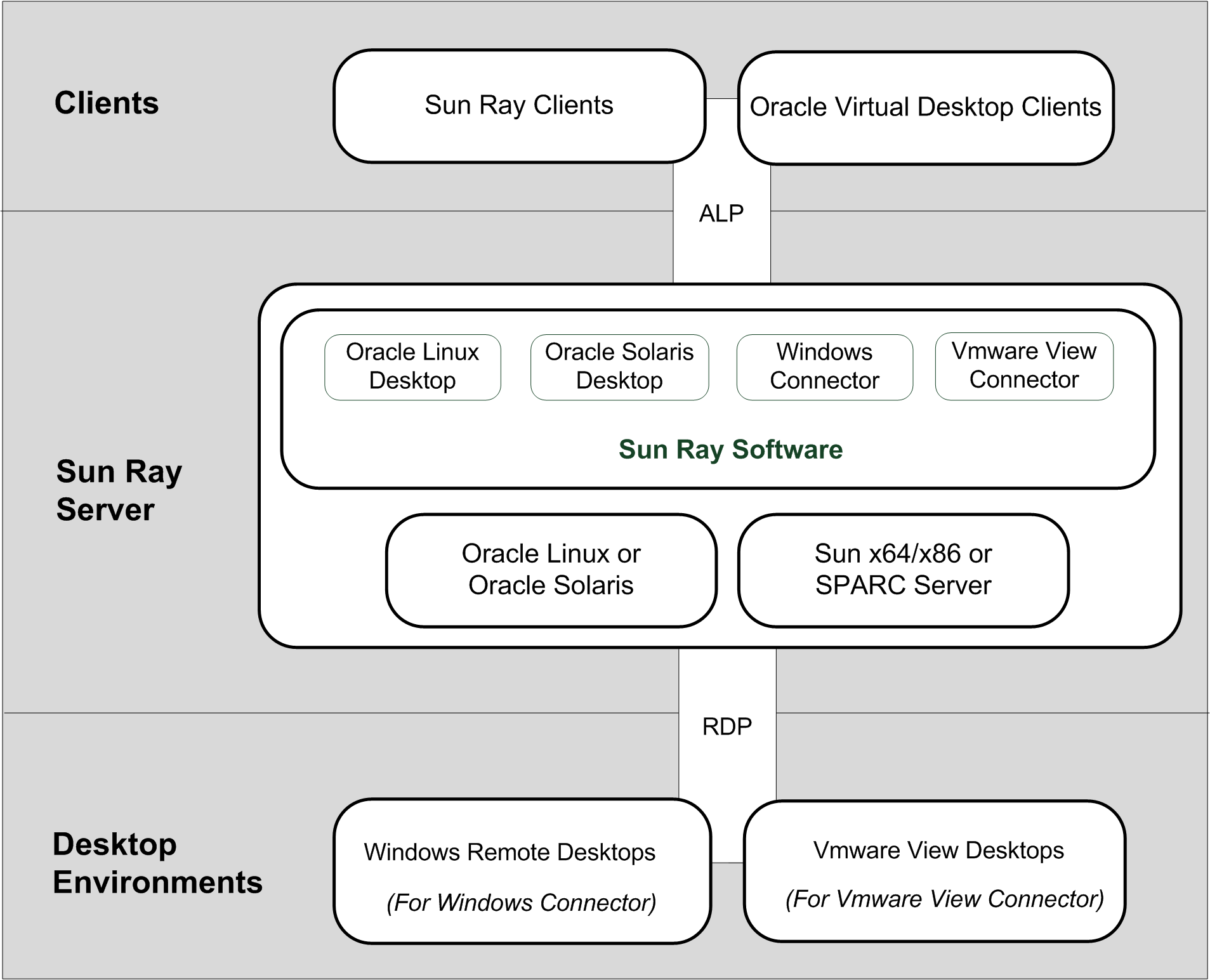The Sun Ray Software is the central piece of the overall Sun Ray environment. From a high-level perspective, a Sun Ray environment consists of three main areas: the clients, the physical network, and the Sun Ray server, where the Sun Ray Software is installed. Figure 1.1, “Parts of the Sun Ray Environment” shows the connections within a Sun Ray environment.
The following sections provide a high-level overview of each area.
Currently, there are two main types of clients: a Sun Ray Client and an Oracle Virtual Desktop Client.
A Sun Ray Client is a hardware unit that can potentially exceed the full functionality of a desktop computer, but with less administrative and environmental costs. A Sun Ray Client acts as a frame buffer on the client side of the network. Applications run on a Sun Ray server and render their output to a virtual frame buffer. The Sun Ray Software formats the rendered output and sends it to the appropriate Sun Ray Client, where the output is interpreted and displayed.
From the point of view of network servers, Sun Ray Clients are identical except for their Ethernet mac address. If a Sun Ray Client ever fails, it can easily be replaced because no data resides on it. An IP addresses is leased to each Sun Ray Client when it is connected and it can be reused when the DTU is disconnected. IP address leasing is managed by DHCP.
Various models of Sun Ray Clients are available, differing primarily with respect to size, type, and supported monitor resolution. However, all Sun Ray Clients include a smart card reader, a keyboard, and a mouse.
For the smart card reader, the industry standard PC/SC-lite API is included for developers who want to encode custom applications or other information in their users' smart cards.
By default, a Sun Ray Client runs the same Oracle Solaris or Oracle Linux operating system as the associated Sun Ray server. However, the Windows and VMware View connectors enable users to access a Windows desktop session or a VMware View session on the client. By configuring kiosk mode, users can bypass the Sun Ray Client operating system altogether and be taken directly to the assigned connector session.
An Oracle Virtual Desktop Client is a software version of a Sun Ray Client. The Oracle Virtual Desktop Client application runs on an ordinary PC or laptop computer and provides a Sun Ray session in a desktop window. It is supported and can be installed on Windows, Linux, Mac OS X, and the iPad. An Oracle Virtual Desktop Client supports most of the standard Sun Ray Client functionality.
As with most networked environments, the Sun Ray environment needs a well-designed network, and it can be configured in one of several possible ways.
For detailed descriptions of the types of network configuration and instructions on configuring each network type, see Chapter 2, Planning a Sun Ray Network Environment.
The Sun Ray server runs the Sun Ray Software and it is the foundation of the Sun Ray environment. It provides all the necessary administrative support for Sun Ray Clients and Oracle Virtual Desktop Clients.
The important first step is determining what operating system environment your users need, and then you can set up your Sun Ray environment accordingly. If your users need an Oracle Linux environment, you can install Oracle Linux on the Sun Ray servers. Vice versa for users who need an Oracle Solaris environment. If your users only plan to use a Windows desktop session, you can choose either Oracle Linux or Oracle Solaris on the Sun Ray server, since the underlying desktop will be hidden from the users. There are a few differences when using Oracle Linux versus the Oracle Solaris operating system for the Sun Ray server, so take that into consideration.
When providing your users with a Windows environment, it is also important to understand how the Sun Ray Software features are supported on different versions of the Windows operating systems in a remote desktop environment. Although most of features are provided for all of the supported Windows platforms, there are differences in how they are implemented.
